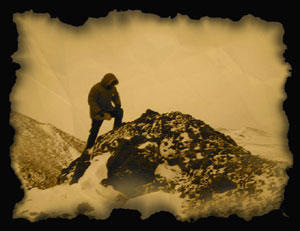Antarctica: Through the eye of a camera

I write this entry, an entry that should have been written long ago, with special thanks to Ash. Ashley, I hope you don't mind, but I wish to start by sharing part of a sentence you wrote to me: "Even though Antarctica seems so harsh, I find it very beautiful, [but] maybe you're just a skilled photo-taker..."
FUZZY WINDOWS
Reading Ashley's words, it struck me just how heavily I have leaned on these photographs in my writing. This blog is a window of sorts, looking out on a strange landscape through thoughts and pictures. But we are a visual species, we experience the world through our eyes, and place more weight on what we see than on what we read.
Which brings me to the heart of the thing. There is an implied question in Ash's words, and it is this: "Is Antarctica really the way it seems through your photographs?" And what an important question that is. He is the first to ask it, albeit indirectly, and I am so glad that he did.
No. Antarctica is not really the way it seems through these photographs, and there are several reasons why. Someone once said that being in Antarctica was like living in an oil painting. . . nothing ever changes. That may be true in the interior, or on the crest of Titan Dome - a flat white expanse touching the rim of the world, but down on Ross Island such statements are little more than poetic license.
The weather changed almost constantly. Photographs capture glimpses, moments "frozen" (appropriately enough) in time. That sense of change, of pregnant stillness, of shifting light, of violent silence that imbued the place is almost absent from my pictures. How I wish a camera could capture such a thing, the true essence of a place. We try of course, we capture some of it, but in its entirety? Too large to fit in the body of a camera. Perhaps too large to fit in the body of a human being.
You disagree. . . You've seen pictures of the sea side, of the mountains, of New York City, and have definitely felt those places through their photographs. Definitely... Maybe..... Maybe not....... What if all you really felt were memories, feelings that already existed within you from your own past? If that is true, photos from Antarctica become problematic. Your memories may not accurately represent what you're looking at. You have no frame of reference. This is not to say that photographs are a waste of time. Obviously, they can convey a great deal. All I'm saying is that they have their limits. The more removed from your own experience, the less successful they can be as windows.
THE CHOICES OF LIMITED SCOPE

And then there is the other problem. . . The limited scope and forced perspective of a lens. I'll spare you the photography lesson, but basically, every picture I took was the result of two things - the choices I made, and the limits of my camera.
As for my choices, Ross Island has great natural beauty - an active volcano, the Barnes Glacier, views of Mt. Discovery and McMurdo Sound. The list is endless. It also has "Mac Town", a naval research station which is anything but beautiful. And so, when I hit the power button on my camera, of course I aimed it away from the trash cans, bulldozed hill sides, and power lines of my home. Then again, McMurdo Station is all but insignificant. Antarctica truly is essentially pristine, and in that sense, the pictures depicting her that way are accurate. It is not dishonest to avoid man-made ugliness in a place where such ugliness is but a tiny fragment of the whole.
Sometimes I had very little choice in the pictures I took. My camera had a maximum exposure time of 15 seconds, which greatly impaired my ability to shoot at night. Countless photos were ruined by the wind, my lack of a tripod, frozen batteries, a lens motor frozen in place, or a lens cover frozen shut. Then there were those awful moments when my body would betray me, when the pain was too great, the cold too severe, and my numb fingers simply refused to push down the button.
So much for my choices. As for the limits of my camera, the 5 megapixel Canon PowerShot had been a last-minute replacement for a better camera stolen in Christchurch. Its built-in lens system was slow, with a narrow field of view and a poor zoom range. For those of you familiar with ISO - that sucked too. A consumer level camera. Still, it served me well, and survived those long months while several of my friends' cameras did not. Incidentally, that rugged little camera finally met its end at the paws of the family cat, which knocked it off a table last month.
So where are we? Photographs do not capture events, only frozen slices - and only the slices the photographer wants, and only the slices the camera can take, and only the slices conditions allow. And once I take them, what then? That's when I selectively choose images to share with people who have never been there, forced to see all of Antarctica through fuzzy windows, fuzzy windows selected from a collection of more than six thousand.
POST PRODUCTION
But there is a final, important issue to address, one I will save for next time. Adobe Photoshop, an amazing piece of software used by photographers around the world. And here we walk on very thin ice indeed, for we have just entered the realm of photographic manipulation. . .
Tune in next time for Part II: "ON THIN ICE" to hear the rest of my sincere answer to Ash's unasked question. . . Is Antarctica really so beautiful, or does the magic of photography make it look that way?


